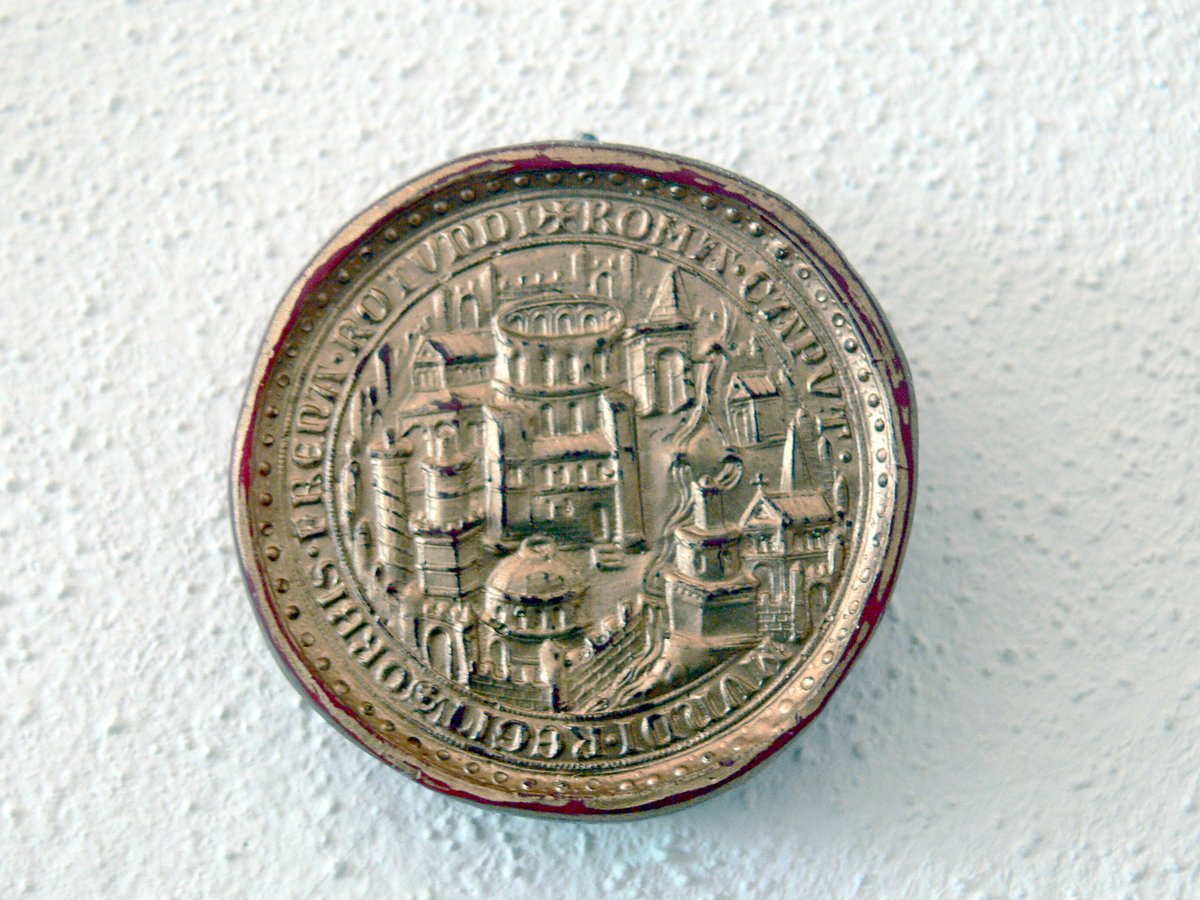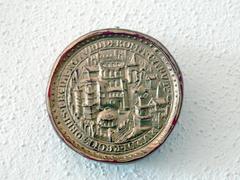
Palazzo Senatorio Visiting Hours, Tickets, and Travel Guide: Rome Historical Sites
Date: 14/06/2025
Introduction: Palazzo Senatorio and Its Significance in Rome
Rising from the summit of Rome’s Capitoline Hill, the Palazzo Senatorio is a monumental embodiment of the city’s political and cultural heritage. As the official city hall since the Middle Ages, it features a remarkable blend of ancient Roman foundations, medieval architecture, and Renaissance artistry—most notably shaped by Michelangelo’s 16th-century vision. Overlooking the Roman Forum and forming the visual centerpiece of the Piazza del Campidoglio, the palace marks the transition from imperial Rome to modern civic governance.
Although the Palazzo Senatorio’s interior is still reserved for municipal functions and typically closed to the public, its stunning exterior, the surrounding piazza, and the Capitoline Museums offer visitors a vivid encounter with Rome’s layered history and artistry. This comprehensive guide equips you with essential information on visiting hours, ticketing, accessibility, guided tours, and nearby attractions, ensuring a memorable and well-informed visit.
For the most current details and official updates, consult the Official Capitoline Museums Website and the Rome Tourism Official Site. For deeper historical context, explore sources like Encyclopaedia Britannica.
Table of Contents
- Introduction
- Overview: Why Visit Palazzo Senatorio?
- Visiting Hours and Ticket Information
- Guided Tours and Accessibility
- Historical Overview
- Architectural Highlights
- Nearby Attractions and Photography Spots
- Practical Visitor Information
- Frequently Asked Questions (FAQ)
- Tips for a Memorable Visit
- References and External Resources
Overview: Why Visit Palazzo Senatorio?
Perched atop Rome’s most storied hill, the Palazzo Senatorio is a must-visit for history enthusiasts, architecture lovers, and travelers seeking to understand Rome’s cultural evolution. Even without interior access, visitors can explore the magnificent piazza designed by Michelangelo, admire the palace’s grand façade and staircase, and enjoy panoramic vistas of the Roman Forum. The adjacent Capitoline Museums offer unparalleled collections of Roman art and artifacts, deepening the experience.
Visiting Hours and Ticket Information
- Palazzo Senatorio Interior: Generally closed to daily public visits, as it functions as Rome’s City Hall. Occasional special guided tours may grant access during cultural events or open days.
- Piazza del Campidoglio and Exterior: Open year-round, accessible at all hours.
- Capitoline Museums: Open daily from 9:30 AM to 7:30 PM (last admission at 6:30 PM). Reduced hours on December 24 and 31; closed January 1, May 1, and December 25.
- Tickets: No ticket is required to explore the piazza or view the palace exterior. Tickets for the Capitoline Museums (which include the ancient Tabularium beneath the palace) can be purchased online or at the museum entrance. Standard adult tickets are €11.50; concessions available. Special exhibitions may affect pricing.
- Special Access: Monitor the Rome Tourism Official Site for announcements regarding special open days or guided tours inside the palace.
Guided Tours and Accessibility
- Guided Tours: While tours inside the Palazzo Senatorio are infrequent, many walking tours of Capitoline Hill include the palace’s history and exterior. The Capitoline Museums offer expert-led and audio/video tours, providing rich context on the palace and its surroundings (My Adventures Across the World).
- Accessibility: The piazza and museum complex are equipped with ramps, elevators, and wheelchair access. The cordonata staircase, though gently sloped, may be challenging for wheelchair users, but museum staff can provide assistance. Contact the museum ahead of your visit for specific accessibility needs.
Historical Overview
Ancient Foundations
The palace is built atop the ancient Tabularium, Rome’s official archives, constructed in 78 BCE. The Tabularium’s sturdy travertine arches remain visible and accessible via the Capitoline Museums, symbolizing the continuity of administrative power from ancient to modern Rome (Summer in Italy; Lonely Planet).
Medieval and Renaissance Transformations
After the decline of the Western Roman Empire, the Capitoline Hill’s political importance waned but was revived in 1143 with the establishment of the Roman Commune. The medieval Palazzo Senatorio emerged as a fortified seat of civic power. In the 16th century, Pope Paul III commissioned Michelangelo to redesign the palace and piazza, transforming them into one of the Renaissance’s greatest urban ensembles (rome.us; Musei Capitolini).
Political and Civic Legacy
Throughout the centuries, the Palazzo Senatorio has been the seat of Rome’s Senate, the city’s mayor, and the municipal council. It remains a living symbol of Roman governance and civic pride, hosting official ceremonies and historical events such as the signing of the Treaties of Rome in 1957 (World History Edu).
Architectural Highlights
Michelangelo’s Redesign
- Façade: The façade, completed after Michelangelo’s death, synthesizes medieval structure with Renaissance order. Features include a rusticated ashlar base, a giant order of Corinthian pilasters, and a balustraded cornice with statues (Musei Capitolini).
- Cordonata Staircase: The double staircase, or cordonata, is both ceremonial and accessible, designed to be ascended on horseback or on foot, and is flanked by statues of the Nile and Tiber rivers and a figure of Minerva (rome.us).
- Towers: Several medieval and Renaissance towers punctuate the structure, including the bell tower (completed in 1582) and towers named after popes Martin V and Nicholas V.
Sculptural and Decorative Features
- Statue of Marcus Aurelius: The piazza’s focal point is a replica of the 2nd-century bronze equestrian statue of Marcus Aurelius (the original is in the Capitoline Museums), preserved due to its mistaken identification as Constantine (Ancient Rome Live).
- Decorative Elements: The façade and staircase are adorned with allegorical figures, heraldic emblems, and classical motifs, celebrating Rome’s civic identity.
Nearby Attractions and Photography Spots
- Capitoline Museums: Adjacent to the palace, these museums house ancient Roman art, sculptures, and the original Marcus Aurelius statue (My Adventures Across the World).
- Roman Forum and Colosseum: Both are within walking distance, offering further immersion into Rome’s history.
- Photo Opportunities: The best times for photography are early morning or late afternoon, when architectural details are illuminated by soft light. The piazza provides panoramic views over the Forum and city skyline.
Practical Visitor Information
Getting There
- Metro: Colosseo station (Line B), followed by a 15-minute walk uphill.
- Bus: Multiple lines stop at Piazza Venezia or Teatro Marcello/Ara Coeli, both near the Capitoline Hill (My Adventures Across the World).
- Walking: The site is accessible on foot from many central Rome landmarks. Wear comfortable shoes due to the hill’s incline.
Facilities
- Restrooms: Available in the Capitoline Museums.
- Accessibility: Ramps, lifts, and barrier-free routes are provided. Wheelchairs available upon request. Special resources are also available for visually and hearing-impaired visitors.
Frequently Asked Questions (FAQ)
Q: Do I need a ticket to visit the Palazzo Senatorio?
A: No ticket is needed to view the exterior or piazza. Tickets are required for the Capitoline Museums and for occasional special guided tours inside the palace.
Q: What are the visiting hours?
A: The piazza is open year-round. The Capitoline Museums are open daily from 9:30 AM to 7:30 PM.
Q: Is the Palazzo Senatorio accessible for wheelchair users?
A: The piazza and museums are accessible, but the staircase is challenging. Contact the museums for assistance.
Q: Are guided tours available?
A: Guided tours of the palace interior are rare and require advance booking. Many tours include the exterior and piazza.
Q: Are photos allowed?
A: Photography is permitted in public areas and the museums (no flash or tripods). Check individual exhibition rules.
Tips for a Memorable Visit
- Check for Special Openings: Monitor official sites for rare opportunities to tour the palace interior.
- Book Museum Tickets in Advance: Avoid long lines by purchasing online.
- Join Guided Tours: Enhance your experience with expert insights and context.
- Plan for Accessibility: Contact museum staff if you have special needs.
- Best Photo Times: Visit early or late in the day for ideal lighting.
References and External Resources
- Official Capitoline Museums Website
- Rome Tourism Official Site
- Encyclopaedia Britannica: Palazzo Senatorio
- Summer in Italy: Palazzo Senatorio Guide
- Lonely Planet: Palazzo Senatorio
- Rome.us: Capitoline Hill and Palazzo Senatorio
- Ancient Rome Live: Capitoline Hill and Palazzo Senatorio
- World History Edu: The Capitoline Museums
- My Adventures Across the World: Capitoline Museums Guide
Conclusion
The Palazzo Senatorio stands as an enduring symbol of Rome’s civic heritage, architectural mastery, and historical continuity. While its interior remains largely off-limits, the accessible piazza and Capitoline Museums offer a rich encounter with the city’s ancient, medieval, and Renaissance past. Plan your visit with the latest information, take in the artistry of Michelangelo’s urban vision, and explore nearby treasures for a comprehensive Roman experience.
To enhance your trip, download the Audiala mobile app for expert guides, interactive maps, and up-to-date announcements. Let your exploration of the Palazzo Senatorio be not just a sightseeing stop, but a journey into the heart of Rome’s living history.


















































































































































































































































